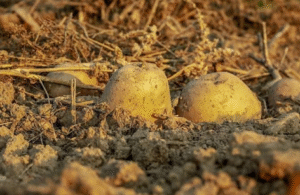
Why in News
-
India is introducing bio-fortified potatoes enriched with iron
-
-
Aim: Tackle micronutrient deficiencies
-
Improve agricultural sustainability
-
-
Developed by the International Potato Center (CIP), Peru
-
-
These potatoes aim to address iron deficiency and hidden hunger
-
-
CIP is also setting up a South Asia regional centre in Agra, Uttar Pradesh
-
-
Purpose: Boost research and seed access in the Indo-Gangetic plains
-
Note: This is the world’s largest potato-producing region
-
What are Bio-Fortified Potatoes
-
New potato variety enriched with higher iron content
-
Developed using:
-
-
Conventional breeding
-
Biotechnology
-
-
Aim:
-
-
Combat iron deficiency
-
Address hidden hunger
-
-
Retain:
-
-
Normal taste
-
Normal yield
-
-
Farmer- and consumer-friendly
-
Initiative led by the International Potato Center (CIP)
-
-
A global leader in tuber crop research
-
Bio-Fortified Sweet Potatoes in India
-
Vitamin A-enriched sweet potatoes are already available in:
-
-
Karnataka
-
Assam
-
West Bengal
-
Odisha
-
-
Plans to expand cultivation to more states
Iron-Fortified Potato Varieties in India
-
CIP shared germplasm with ICAR-Central Potato Research Institute (CPRI), Shimla
-
An iron-rich potato variety released in Peru:
-
-
Currently under evaluation for Indian agro-climatic conditions
-
-
The new Agra centre will:
-
-
Support research and development
-
Help with seed distribution across South Asia
-
Other Biofortified Crop Initiatives by ICAR
-
ICAR released biofortified seed varieties in 61 crops:
-
34 field crops
-
Cereals
-
Pulses
-
Millets
-
Oilseeds
-
-
27 horticultural crops
-
Tubers
-
Vegetables
-
Medicinal plants
-
-
Examples
-
CR Dhan 416:
-
-
Salinity-resistant rice
-
Multiple pest resistances
-
-
Durum Wheat:
-
-
High in zinc (41.1 ppm) and iron (38.5 ppm)
-
Contains 12% protein
-
Suitable for irrigated areas
-
About Biofortification
-
Process of enhancing nutrient content of crops using:
-
-
Conventional breeding
-
Agronomic techniques
-
Modern biotechnology
-
-
Boosts:
-
-
Vitamin levels
-
Mineral levels in staple crops
-
-
Helps in reducing malnutrition




